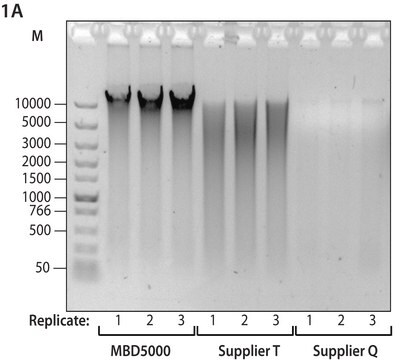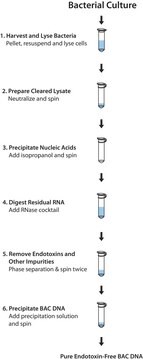Key Documents
NA2100
GenElute™ Bacterial Genomic DNA Kits
sufficient for 10 purifications
Synonim(y):
Bacterial Genomic DNA, Gen Elute
About This Item
Polecane produkty
Powiązane kategorie
Opis ogólny
The kit combines the advantages of a silica-based system with a microspin format and eliminates the need for expensive resins, alcohol precipitation, and hazardous organic compounds such as phenol and chloroform.
Zastosowanie
- restriction endonuclease digestions
- PCR
- Southern blots
- cloning
Cechy i korzyści
- Starting material: Up to 1.5 mL of culture
- Expected yield: Up to 20 μg
- Elution volume: 400 μl
- Time required: 70 - 120 min
- A260/A280 ratio: 1.6 - 1.9
- No phenol, chloroform, or ethanol precipitation required
Zasada
The expected yield of genomic DNA will vary depending on the cell density of the bacterial culture and the bacterial species and strain used. DNA purified with the GenElute kit has an A260/A280 ratio between 1.6 and 1.9 and can be up to 50 kb in length.
Inne uwagi
Informacje prawne
Elementy zestawu są też dostępne oddzielnie
polecane
produkt powiązany
Hasło ostrzegawcze
Danger
Zwroty wskazujące rodzaj zagrożenia
Zwroty wskazujące środki ostrożności
Klasyfikacja zagrożeń
Acute Tox. 4 Oral - Eye Irrit. 2 - Flam. Liq. 3 - Met. Corr. 1 - Resp. Sens. 1 - Skin Irrit. 2 - STOT SE 3
Organy docelowe
Central nervous system, Respiratory system
Kod klasy składowania
3 - Flammable liquids
Certyfikaty analizy (CoA)
Poszukaj Certyfikaty analizy (CoA), wpisując numer partii/serii produktów. Numery serii i partii można znaleźć na etykiecie produktu po słowach „seria” lub „partia”.
Masz już ten produkt?
Dokumenty związane z niedawno zakupionymi produktami zostały zamieszczone w Bibliotece dokumentów.
Klienci oglądali również te produkty
Protokoły
GenElute Bacterial Genomic DNA Kit protocol describes a simple and convenient way for the isolation of pure genomic DNA from bacteria.
Protokół GenElute™ Bacterial Genomic DNA Kit opisuje prosty i wygodny sposób izolacji czystego genomowego DNA z bakterii.
Nasz zespół naukowców ma doświadczenie we wszystkich obszarach badań, w tym w naukach przyrodniczych, materiałoznawstwie, syntezie chemicznej, chromatografii, analityce i wielu innych dziedzinach.
Skontaktuj się z zespołem ds. pomocy technicznej














